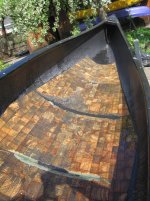If memory serves, a prior thread indicated that Muskrat, Alan Gage, and perhaps some others had some experience using Lantor Coremat. I am currently attempting to apply the thinnest variety of Coremat (1.4mm) to rebuild the bottom of a canoe and applied the first of three pieces yesterday. I would welcome any suggestions for its use from those who have used it, or similar microsphere-embedded, non-woven polyester core materials such as Spherocore.
In my application, the Coremat will be sandwiched between two layers of 4 ounce/square yard S-2 glass cut on different biases. I am working alone and the Coremat pieces are relatively large, 1 meter in length by up to 36 inches in maximal width. I am using West Systems epoxy (105/206). I do not feel it is possible to pre-saturate the Coremat prior to laying it in without creating a big mess, so what I did with the first piece was to apply a coat of epoxy, lay down the Coremat, and continue applying epoxy to the surface with a squeege until it seemed adequately saturated, then rolling it thoroughly with a grooved aluminum roller. I had hoped that this application method would be adequate due to the thinness of the material I am using.
I expected resin consumption to be considerable but it seemed to be a bit greater than I anticipated and I am still not entirely sure I completely saturated it, and I think I might have over-rolled it a bit given that it is somewhat compressible. Any suggestions regarding epoxy application and how to judge adequate resin saturation would be most welcome.
In my application, the Coremat will be sandwiched between two layers of 4 ounce/square yard S-2 glass cut on different biases. I am working alone and the Coremat pieces are relatively large, 1 meter in length by up to 36 inches in maximal width. I am using West Systems epoxy (105/206). I do not feel it is possible to pre-saturate the Coremat prior to laying it in without creating a big mess, so what I did with the first piece was to apply a coat of epoxy, lay down the Coremat, and continue applying epoxy to the surface with a squeege until it seemed adequately saturated, then rolling it thoroughly with a grooved aluminum roller. I had hoped that this application method would be adequate due to the thinness of the material I am using.
I expected resin consumption to be considerable but it seemed to be a bit greater than I anticipated and I am still not entirely sure I completely saturated it, and I think I might have over-rolled it a bit given that it is somewhat compressible. Any suggestions regarding epoxy application and how to judge adequate resin saturation would be most welcome.
Last edited:

